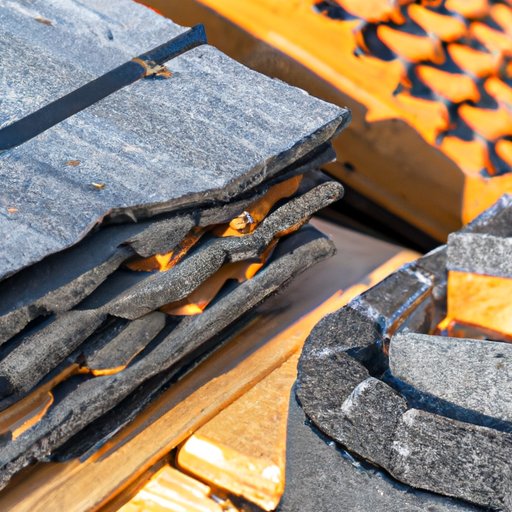
I. Introduction
When it comes to roofing projects, understanding the weight of each material is vital to ensure a successful installation and maintenance process. Shingle bundles are among the essential materials used in roofing projects, and it is crucial to know how much they weigh to determine the right amount needed for the project. This article will explore everything you need to know about shingle bundle weights and how it affects your roofing project.
II. All You Need to Know About Shingle Bundles: Their Weights and Cost
Shingle bundles are pre-packaged units of shingles used in roofing projects. They come in different types, such as asphalt, fiberglass, wood, and slate, with varying weights and costs. The weight and cost may also vary depending on the manufacturer, quality, and thickness of the shingle. Typically, the standard weight per one bundle of shingles is between 45 to 80 pounds.
The cost of shingle bundles varies based on the brand, type, and quality, with the more premium and durable ones costing more. It is important to find out the weight and cost of the shingle bundle you plan to use before starting your roofing project to ensure you have enough materials and budget.
Calculating the number of shingle bundles required for a roofing project depends on the size of the roof and the pitch. To determine the number of bundles needed, you can use the roofing square footage and divide it by the bundle coverage area. Typically, one bundle covers an area of 33.3 to 33.75 square feet.
III. Light vs. Heavy Shingle Bundles: Which One to Choose for Your Roofing Project
There are two types of shingle bundles: light and heavy. Light shingle bundles, also known as 3-tab shingles, are thinner, weighing between 50 to 60 pounds per bundle and cover less area. Heavy shingle bundles, also known as architectural or dimensional shingles, are thicker and weigh between 65 to 80 pounds per bundle, covering more area.
The advantage of light shingle bundles is that they are cheaper, easy to install, and efficient in moderate weather conditions. However, they lack durability and may not last as long as heavy shingle bundles. Heavy shingle bundles, on the other hand, are more expensive, durable, and ideal for harsh weather conditions.
When it comes to choosing the right shingle bundle weight for your roofing project, several factors influence the decision. Some of these factors include the location of the building, roofing design, pitch, climate, budget, and personal preference.
IV. Calculating the Total Weight of Your Roofing Materials: A Guide to Shingle Bundles
Calculating the total weight of roofing materials used in a project is crucial for proper installation and ensures the structural integrity of the roof. To calculate the total weight of your roofing materials, including shingle bundles, you need to know the weight per square foot of your roof.
The weight of one bundle of shingles per square foot can be determined by multiplying the number of shingles in a bundle by the weight of one shingle and dividing the result by the number of square feet covered by the bundle. For example, if one bundle of shingles weighs 75 pounds and covers an area of 33.33 square feet, the weight per square foot will be 2.25 pounds (75/33.33).
To determine the total weight of shingle bundles needed for your roofing project, you have to calculate the square foot of your roof. Then you can multiply the weight per square foot of the shingle bundle by the total square foot of the roof.
V. The Impact of Shingle Bundle Weights on Roofing Installation and Maintenance
The weight of the shingle bundle affects the installation process and must be considered during the planning phase. Heavy shingle bundles may cause more significant strain on roofers, making the installation process more challenging and time-consuming if not handled with care. On the other hand, light shingle bundles are easier to install, and the installation process takes a shorter time.
It is vital to know the weight of each shingle bundle before installing it to ensure safety precautions are taken and proper lifting techniques are applied. Failure to observe the weight limits may lead to injury, damage to the shingles, or the roof’s structural integrity.
Shingle bundle weight also affects maintenance and repair works on the roof. Heavy shingle bundles may require more labor when undertaking repairs and maintenance works. Consequently, their maintenance and repair costs are relatively higher compared to light shingle bundles.
VI. How to Safely Handle and Transport Heavy Shingle Bundles: Tips from Roofing Experts
When handling heavy shingle bundles, certain precautions must be taken by the roofer to ensure their safety and prevent damage to the roof or shingles. It is advisable to work in pairs or teams when handling shingles and to use tools such as hoists, cranes, and jacks to distribute the weight evenly.
It is also essential to use proper lifting techniques, such as lifting with your legs and not your back, to avoid strains and injuries. Safety equipment such as gloves, protective clothing, and boots should be worn during the handling and transportation of shingle bundles.
VII. Conclusion
Knowing the weight of shingle bundles is essential for the successful completion of a roofing project. Choosing the right weight of shingle bundle depends on several factors such as location, pitch, design, climate, budget, and personal preferences. Heavy shingle bundles may be more durable, but they require more work to install and maintain. Light shingle bundles are cheaper and easier to install but lack durability. Knowing their weights influences their handling, maintenance, and repair work, and intermittent safety measures must be put in place. By considering the factors discussed in this article, you should be able to choose the right shingle bundle weight for your roofing project.




